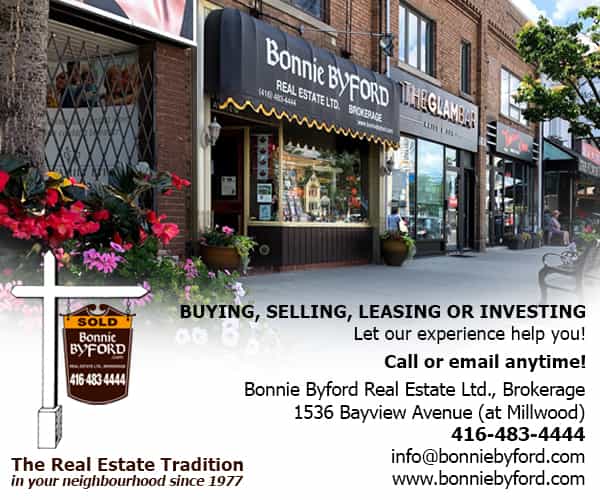The much-anticipated update on the Leaside Neighbourhood Transportation plan was revealed in early June, with near-term improvements proposed:
Phase I: “Quick wins”
This phase of the plan is to deliver the “quick wins” – interventions that could be delivered with minimal fuss and take immediate effect. From an active transportation perspective, there are encouraging signs. A signalized crossing to Mount Pleasant Cemetery at Bayview and Sutherland will improve safety and accessibility for people visiting the cemetery by bike and on foot. Conversion of diagonal to parallel parking on McRae from Laird to Rumsey is a very good first step. Our BikeShare network is expanding – a station was added at the library, another is planned for Laird and McRae, and more will come with the installation of the Eglinton bikeway and Millwood Road improvements near Thorncliffe Park. Improvements at four intersections are another plus. Anytime you can slow vehicles and improve visibility of people walking and biking through design, it’s good for road safety. But Phase I has little to offer in terms of dealing with Leaside’s nemesis: “cut through” traffic.
Phase II: 2025 and beyond
The opportunity for major reforms is through the longer-term plan, which is dependent on emerging travel patterns once the Line 5 LRT and the Eglinton bikeway are open. We should also have updated results of the Transportation Tomorrow survey (the 2021 survey was deferred to 2022/23 due to the pandemic) for an updated view of how Leasiders currently get around. It is at this phase that significant changes to road design, travel routes, a neighbourhood cycling network, traffic calming and measures to discourage “cut through” traffic will be considered. But according to data reported by the City, this may be a challenge for us.
The uncomfortable truth – we are traffic
From data shared, it seems we are a car-loving lot, making most of our journeys by car and many of them for distances that could be walked or cycled. We’re not big on transit or biking and most of the traffic (at least in 2016) in the neighbourhood was us, or our very close neighbours. Furthermore, according to one of the enforcement officers at the community consultation on June 7th, we account for about 45% of the traffic infractions.
The uncomfortable truth is that if we want fewer people driving on our streets, we have to make it less attractive to do so. Are Leasiders ready to embrace changes that could make it a little harder for them to get around so that others avoid our streets?
We also need to make it attractive for people to choose other modes – transit, cycling and walking, especially for short trips. So what changes are needed to encourage more car-free travel in the neighbourhood? What would you need to see to switch from driving to walking your children to school, biking to run errands and taking transit for a night out downtown?
If Leaside wants to get serious about a transportation plan – a plan that improves road safety, reduces vehicle volumes and supports climate action – these are the questions we need to be asking.
Read Carol Burtin Fripp’s LRA update this month to learn more.


